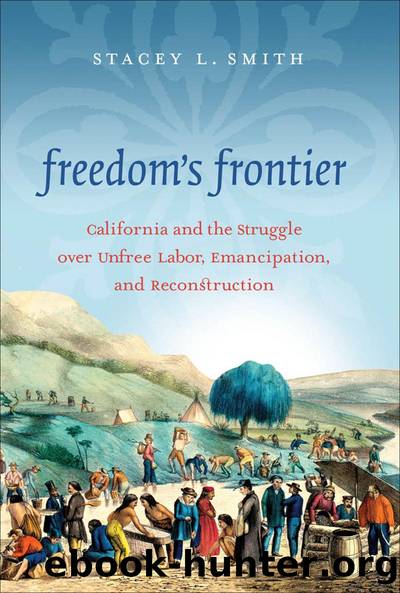Freedom's Frontier by Stacey L. Smith

Author:Stacey L. Smith [Smith, Stacey L.]
Language: eng
Format: epub
Tags: History, United States, State & Local, West (AK; CA; CO; HI; ID; MT; NV; UT; WY), Political Science, Labor & Industrial Relations, Social Science, Slavery
ISBN: 9781469607689
Google: 6-fxohGj9XgC
Publisher: UNC Press Books
Published: 2013-01-15T16:06:23+00:00
Trafficking Chinese Women in California
In 1861, the Trinity Journal, a northwestern California newspaper that carried dozens of stories about the dangers of squaw men, turned its attention to a different social evil. Since the early 1850s, gold deposits had lured thousands of miners to the Trinity-Shasta area. Among these new migrants were hundreds of Chinese men and a lesser number of Chinese women. Like many other California newsmen before him, the Trinity editor fretted about the dangers of this new population, and he repeated familiar anti-Chinese arguments. Chinese men depressed white menâs wages by working cheaply; they carried the stateâs mineral resources off to China; they were coolie slaves owned by Chinese merchants. He concluded, however, that Chinese gender relations posed the greatest problem for the state. âMost Chinese women in California are slaves,â he assured his readers, âas abject and servile as the blackest, kinky-headed negro in Louisiana.â Chinese womenâs enslavement was predicated on sex rather than on race. It was their fate, as women, to be âbought and sold among male Chinamen as any other property.â45 Combating Californiaâs âChinese Problemâ required eliminating the sale of women that underpinned Chinese gender relations.
The Journal editorâs focus on the enslavement of Chinese women illuminates the shifting ground of anti-Chinese sentiment in California across the 1850s. Ever since the gold rush, calls for Chinese exclusion focused on the alleged unfree status of male Chinese âcoolies.â The arrival of greater numbers of Chinese women, many of whom worked in the commercialized sex trade, brought the status of Chinese prostitutes to the forefront of the anti-Chinese critique. Taking aim at Chinatown brothels, opponents of Chinese immigration insisted that the way Chinese migrants organized their sexual and gender relations posed as much of a threat to the stateâs social and moral order as the coolie trade. Much like the protests against Indian womenâs captivity, criticisms of Chinese prostitution focused on womenâs sexual servitude and the way it subverted idealized white visions of middle-class home and family life. Anti-Chinese critics argued that rather than being wives and mothers, almost all Chinese women in the state were enslaved prostitutes whose bodies, labor, and sexual virtue were freely bartered among their countrymen. At times, whites blamed this trade on male Chinese procurers and brothel keepers, brutal slaveholders who profited from buying and selling both the persons and the sexual services of Chinese women. At other times, however, they attributed the traffic in bound prostitutes to Chinese gender, family, and household relations. They argued that all Chinese men were tyrannical patriarchs who claimed outrageous property rights in their female kin and freely bought and sold their wives and daughters into prostitution. Instead of shielding women from the market, Chinese men regarded them as commodities and treated intimate relations of home and family as mere economic transactions. Chinese women were never wholly innocent victims in these narratives. They lacked natural feminine virtues of modesty and chastity, and these weaknesses often contributed to their downfall. Ultimately, traffics in Chinese women came
Download
This site does not store any files on its server. We only index and link to content provided by other sites. Please contact the content providers to delete copyright contents if any and email us, we'll remove relevant links or contents immediately.
International Integration of the Brazilian Economy by Elias C. Grivoyannis(57394)
The Radium Girls by Kate Moore(10918)
Turbulence by E. J. Noyes(7059)
Nudge - Improving Decisions about Health, Wealth, and Happiness by Thaler Sunstein(6644)
The Black Swan by Nassim Nicholas Taleb(6205)
Pioneering Portfolio Management by David F. Swensen(5616)
Rich Dad Poor Dad by Robert T. Kiyosaki(5167)
Zero to One by Peter Thiel(4836)
Man-made Catastrophes and Risk Information Concealment by Dmitry Chernov & Didier Sornette(4750)
Secrecy World by Jake Bernstein(3790)
Millionaire: The Philanderer, Gambler, and Duelist Who Invented Modern Finance by Janet Gleeson(3576)
Skin in the Game by Nassim Nicholas Taleb(3480)
The Age of Surveillance Capitalism by Shoshana Zuboff(3432)
The Money Culture by Michael Lewis(3292)
Skin in the Game: Hidden Asymmetries in Daily Life by Nassim Nicholas Taleb(3273)
Bullshit Jobs by David Graeber(3190)
The Dhandho Investor by Mohnish Pabrai(3176)
The Wisdom of Finance by Mihir Desai(3087)
Blockchain Basics by Daniel Drescher(2896)
